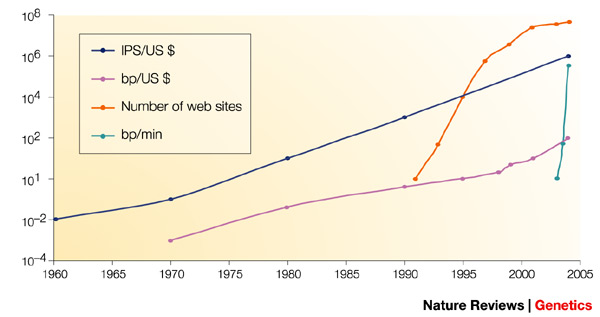|
Monday, August 01, 2005
Nature News reports on the successful application of a new sequencing technology:
Writing in Nature, Marcel Margulies, Michael Egholm and colleagues describe a method that they say reads genomes 100 times faster than the current technology, which is based on a tried and true technique called the Sanger method. There are still important caveats with the current state of this new technology, but it's exciting nonetheless. The cost/speed of sequencing technology has increased exponentially since its invention. However, most performance increases in the past have come by optimizing the Sanger technique. Future advances will depend on developing new technologies. NIH has set a goal is a $1000 personalized human genome sequence. A 2004 review gives some perspective:  The dark-blue plot indicates the Kurzweil/Moore's Law108: it describes the doubling of computer instructions per second per US dollar (IPS/US $) that has been occurring approximately every 18 months since 1900. The magenta plot indicates an exponential growth in the number of base pairs of accurate DNA sequence per unit cost (bp/US $) as a function of time1. To some extent, the doubling time for DNA mimics the IPS/US $ curve because it is dependent on it. An even steeper segment occurs in the orange curve; this depicts the number of web sites (doubling time of four months)109 and shows how quickly a technology can explode when a protocol that can be shared spreads through an existing infrastructure. The turquoise plot is an 'Open Source' case study of 'FLUORESCENT IN SITU SEQUENCING' with polonies40 (see main text for details of this DNA-sequencing technology) in bp/min on simple test templates (doubling time of one month). |



